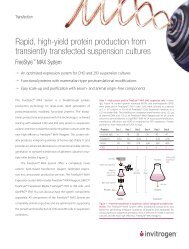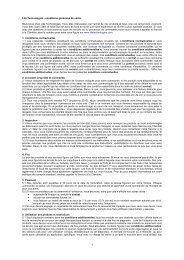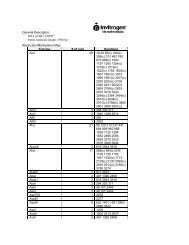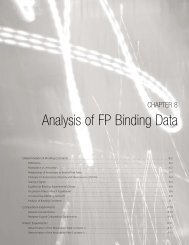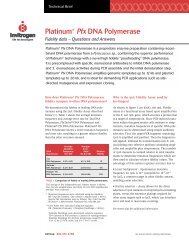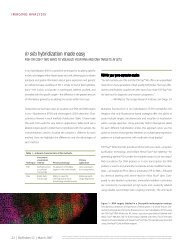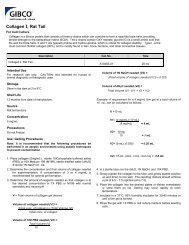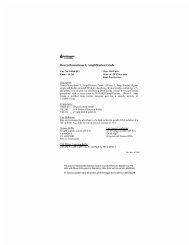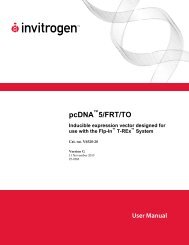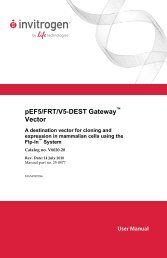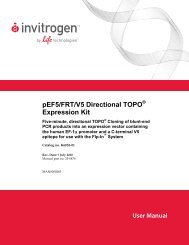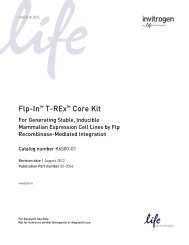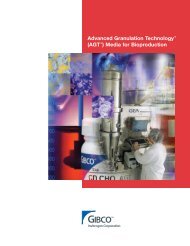Ni-NTA Purification System - Invitrogen
Ni-NTA Purification System - Invitrogen
Ni-NTA Purification System - Invitrogen
You also want an ePaper? Increase the reach of your titles
YUMPU automatically turns print PDFs into web optimized ePapers that Google loves.
<strong>Ni</strong>-<strong>NTA</strong> <strong>Purification</strong> <strong>System</strong><br />
For purification of polyhistidine-containing<br />
recombinant proteins<br />
Catalog nos. K950-01, K951-01, K952-01, K953-01, K954-01,<br />
R901-01, R901-10, R901-15<br />
Version C<br />
7 August 2006<br />
25-0496<br />
User Manual
Table of Contents<br />
Kit Contents and Storage..................................................................................................................................... iv<br />
Accessory Products .............................................................................................................................................. vi<br />
Introduction .................................................................................................................................1<br />
Overview .................................................................................................................................................................1<br />
Methods .......................................................................................................................................2<br />
Preparing Cell Lysates...........................................................................................................................................2<br />
<strong>Purification</strong> Procedure—Native Conditions.......................................................................................................7<br />
<strong>Purification</strong> Procedure—Denaturing Conditions ............................................................................................11<br />
<strong>Purification</strong> Procedure—Hybrid Conditions....................................................................................................13<br />
Troubleshooting....................................................................................................................................................15<br />
Appendix....................................................................................................................................17<br />
Additional Protocols ............................................................................................................................................17<br />
Recipes ...................................................................................................................................................................18<br />
Frequently Asked Questions...............................................................................................................................21<br />
Technical Service ..................................................................................................................................................22<br />
References..............................................................................................................................................................23<br />
iii
Kit Contents and Storage<br />
Types of Products This manual is supplied with the following products:<br />
<strong>System</strong><br />
Components<br />
iv<br />
Kit Name Catalog No.<br />
<strong>Ni</strong>-<strong>NTA</strong> <strong>Purification</strong> <strong>System</strong> K950-01<br />
<strong>Ni</strong>-<strong>NTA</strong> <strong>Purification</strong> <strong>System</strong> with Antibody<br />
with Anti-Xpress Antibody K951-01<br />
with Anti-myc-HRP Antibody K952-01<br />
with Anti-His(C-term)-HRP Antibody K953-01<br />
with Anti-V5-HRP Antibody K954-01<br />
<strong>Ni</strong>-<strong>NTA</strong> Agarose (10 ml) R901-01<br />
<strong>Ni</strong>-<strong>NTA</strong> Agarose (25 ml) R901-15<br />
<strong>Ni</strong>-<strong>NTA</strong> Agarose (100 ml) R901-10<br />
The <strong>Ni</strong>-<strong>NTA</strong> <strong>Purification</strong> <strong>System</strong> components are listed below and include<br />
enough resin, reagents, and columns for six purifications.<br />
Component Composition Quantity<br />
<strong>Ni</strong>-<strong>NTA</strong> Agarose 50% slurry in 30% ethanol 10 ml<br />
5X Native<br />
<strong>Purification</strong> Buffer<br />
Guanidinium Lysis<br />
Buffer<br />
Denaturing Binding<br />
Buffer<br />
Denaturing Wash<br />
Buffer<br />
Denaturing Elution<br />
Buffer<br />
250 mM NaH2PO4, pH 8.0<br />
2.5 M NaCl<br />
6 M Guanidine HCl<br />
20 mM sodium phosphate, pH 7.8<br />
500 mM NaCl<br />
8 M Urea<br />
20 mM sodium phosphate, pH 7.8<br />
500 mM NaCl<br />
8 M Urea<br />
20 mM sodium phosphate, pH 6.0<br />
500 mM NaCl<br />
8 M Urea<br />
20 mM NaH2PO4, pH 4.0<br />
500 mM NaCl<br />
Imidazole 3 M Imidazole<br />
20 mM sodium phosphate, pH 6.0<br />
500 mM NaCl<br />
1 × 125 ml bottle<br />
1 × 60 ml bottle<br />
2 × 125 ml bottles<br />
2 × 125 ml bottles<br />
1 × 60 ml bottle<br />
1 × 8 ml bottle<br />
<strong>Purification</strong> columns 10 ml columns 6
Kit Contents and Storage, Continued<br />
<strong>Ni</strong>-<strong>NTA</strong> <strong>Purification</strong><br />
<strong>System</strong> with<br />
Antibody<br />
The <strong>Ni</strong>-<strong>NTA</strong> <strong>Purification</strong> <strong>System</strong> with Antibody includes resin, reagents, and<br />
columns as described for the <strong>Ni</strong>-<strong>NTA</strong> <strong>Purification</strong> <strong>System</strong> (previous page) and<br />
50 µl of the appropriate purified mouse monoclonal antibody. Sufficient<br />
reagents are included to perform six purifications and 25 Western blots with the<br />
antibody.<br />
For more details on the antibody specificity, subclass, and protocols for using<br />
the antibody, refer to the antibody manual supplied with the system.<br />
Storage Store <strong>Ni</strong>-<strong>NTA</strong> Agarose at +4°C. Store buffers and columns at room<br />
temperature.<br />
Resin and Column<br />
Specifications<br />
Product<br />
Qualification<br />
Limited Use Label<br />
License No. 102:<br />
<strong>Ni</strong>-<strong>NTA</strong> Resin<br />
Store the antibody at 4°C. Avoid repeated freezing and thawing of the<br />
antibody as it may result in loss of activity.<br />
The product is guaranteed for 6 months when stored properly.<br />
All native purification buffers are prepared from the 5X Native <strong>Purification</strong><br />
Buffer and the 3 M Imidazole, as described on page 7.<br />
The Denaturing Wash Buffer pH 5.3 is prepared from the Denaturing Wash<br />
Buffer (pH 6.0), as described on page 11.<br />
<strong>Ni</strong>-<strong>NTA</strong> Agarose is precharged with <strong>Ni</strong> 2+ ions and appears blue in color. It is<br />
provided as a 50% slurry in 30% ethanol.<br />
<strong>Ni</strong>-<strong>NTA</strong> Agarose and purification columns have the following specifications:<br />
• Binding capacity of <strong>Ni</strong>-<strong>NTA</strong> Agarose: 5–10 mg of protein per ml of resin<br />
• Average bead size: 45–165 microns<br />
• Pore size of purification columns: 30–35 microns<br />
• Recommended flow rate: 0.5 ml/min<br />
• Maximum linear flow rate: 700 cm/h<br />
• Maximum pressure: 2.8 psi (0.2 bar)<br />
• Column material: Polypropylene<br />
• pH stability (long term): 3–13<br />
• pH stability (short term): 2–14<br />
The <strong>Ni</strong>-<strong>NTA</strong> <strong>Purification</strong> <strong>System</strong> is qualified by purifying 2 mg of myoglobin<br />
protein on a column and performing a Bradford assay. Protein recovery must<br />
be 75% or higher.<br />
The <strong>Ni</strong>-<strong>NTA</strong> Agarose contained in this product is manufactured by QIAGEN ®<br />
under a license from Hoffmann-LaRoche Inc., Nutley, NJ and/or Hoffmann-<br />
LaRoche Ltd., Basel, Switzerland and is provided only for use in research.<br />
Information about licenses for commercial use is available from QIAGEN<br />
GmbH, Max-Volmer-Strasse 4, D-40724 Hilden, Germany.<br />
v
Accessory Products<br />
Additional<br />
Products<br />
Pre-Cast Gels and<br />
Pre-made Buffers<br />
vi<br />
The following products are also available for order from <strong>Invitrogen</strong>:<br />
Product Quantity Catalog No.<br />
ProBond <strong>Ni</strong>ckel-Chelating Resin 50 ml<br />
150 ml<br />
R801-01<br />
R801-15<br />
Polypropylene columns (empty) 50 R640-50<br />
<strong>Ni</strong>-<strong>NTA</strong> Agarose 10 ml<br />
25 ml<br />
100 ml<br />
R901-01<br />
R901-15<br />
R901-10<br />
ProBond <strong>Purification</strong> <strong>System</strong> 6 purifications K850-01<br />
ProBond <strong>Purification</strong> <strong>System</strong> with<br />
Antibody<br />
with Anti-Xpress Antibody 1 kit K851-01<br />
with Anti-myc-HRP Antibody 1 kit K852-01<br />
with Anti-His(C-term)-HRP Antibody 1 kit K853-01<br />
with Anti-V5-HRP Antibody 1 kit K854-01<br />
Anti-myc Antibody 50 µl R850-25<br />
Anti-V5 Antibody 50 µl R960-25<br />
Anti-Xpress Antibody 50 µl R910-25<br />
Anti-His(C-term) Antibody 50 µl R930-25<br />
InVision His-tag In-gel Stain 500 ml LC6030<br />
InVision His-tag In-gel Staining Kit 1 kit LC6033<br />
A large variety of pre-cast gels for SDS-PAGE and pre-made buffers for your<br />
convenience are available from <strong>Invitrogen</strong>. For details, visit our web site at<br />
www.invitrogen.com or contact Technical Service (page 22).
Overview<br />
Introduction<br />
Introduction The <strong>Ni</strong>-<strong>NTA</strong> <strong>Purification</strong> <strong>System</strong> is designed for purification of 6xHis-tagged<br />
recombinant proteins expressed in bacteria, insect, and mammalian cells. The<br />
system is designed around the high affinity and selectivity of <strong>Ni</strong>-<strong>NTA</strong> Agarose<br />
for recombinant fusion proteins that are tagged with six tandem histidine<br />
residues.<br />
The <strong>Ni</strong>-<strong>NTA</strong> <strong>Purification</strong> <strong>System</strong> is a complete system that includes<br />
purification buffers and resin for purifying proteins under native, denaturing,<br />
or hybrid conditions. The resulting proteins are ready for use in many target<br />
applications.<br />
This manual is designed to provide generic protocols that can be adapted for<br />
your particular proteins. The optimal purification parameters will vary with<br />
each protein being purified.<br />
<strong>Ni</strong>-<strong>NTA</strong> Resin <strong>Ni</strong>-<strong>NTA</strong> Agarose is used for purification of recombinant proteins expressed in<br />
bacteria, insect, and mammalian cells from any 6xHis-tagged vector. The resin<br />
exhibits high affinity and selectivity for 6xHis-tagged recombinant fusion<br />
proteins.<br />
Binding<br />
Characteristics<br />
Native Versus<br />
Denaturing<br />
Conditions<br />
Proteins can be purified under native, denaturing, or hybrid conditions using<br />
the <strong>Ni</strong>-<strong>NTA</strong> Agarose. Proteins bound to the resin are eluted with low pH<br />
buffer or by competition with imidazole or histidine. The resulting proteins are<br />
ready for use in target applications.<br />
The protocols provided in this manual are generic, and may not result in 100%<br />
pure protein. These protocols should be optimized based on the binding<br />
characteristics of your particular proteins.<br />
<strong>Ni</strong>-<strong>NTA</strong> Agarose uses nitrilotriacetic acid (<strong>NTA</strong>), a tetradentate chelating<br />
ligand, in a highly cross-linked 6% agarose matrix. <strong>NTA</strong> binds <strong>Ni</strong> 2+ ions by four<br />
coordination sites.<br />
The decision to purify 6xHis-tagged proteins under native or denaturing<br />
conditions depends on the solubility of the protein and the need to retain<br />
biological activity for downstream applications.<br />
• Use native conditions if your protein is soluble (in the supernatant after lysis)<br />
and you want to preserve protein activity.<br />
• Use denaturing conditions if the protein is insoluble (in the pellet after lysis)<br />
or if your downstream application does not depend on protein activity.<br />
• Use hybrid protocol if your protein is insoluble but you want to preserve<br />
protein activity. Prepare the lysate and columns under denaturing conditions<br />
and then use native buffers during the wash and elution steps to refold the<br />
protein. Note that this protocol may not restore activity for all proteins. See<br />
page 14.<br />
1
Preparing Cell Lysates<br />
Methods<br />
Introduction Instructions for preparing lysates from bacteria, insect, and mammalian cells<br />
using native or denaturing conditions are described below.<br />
Materials Needed You will need the following items:<br />
Processing Higher<br />
Amount of Starting<br />
Material<br />
2<br />
• Native Binding Buffer (recipe is on page 8) for preparing lysates under<br />
native conditions<br />
• Sonicator<br />
• 10 µg/ml RNase and 5 µg/ml DNase I (optional)<br />
• Guanidinium Lysis Buffer (supplied with the system) for preparing lysates<br />
under denaturing conditions<br />
• 18-gauge needle<br />
• Centrifuge<br />
• Sterile, distilled water<br />
• SDS-PAGE sample buffer<br />
• Lysozyme for preparing bacterial cell lysates<br />
• Bestatin or leupeptin, for preparing mammalian cell lysates<br />
Instructions for preparing lysates from specific amount of starting material<br />
(bacteria, insect, and mammalian cells) and purification using 2 ml resin under<br />
native or denaturing conditions are described in this manual.<br />
If you wish to purify your protein of interest from higher amounts of starting<br />
material, you may need to optimize the lysis protocol and purification<br />
conditions (amount of resin used for binding). The optimization depends on the<br />
expected yield of your protein and amount of resin to use for purification.<br />
Perform a pilot experiment to optimize the purification conditions and then<br />
based on the pilot experiment results, scale-up accordingly.<br />
Continued on next page
Preparing Cell Lysates, Continued<br />
Preparing Bacterial<br />
Cell Lysate—Native<br />
Conditions<br />
Follow the procedure below to prepare bacterial cell lysate under native<br />
conditions. Scale up or down as necessary.<br />
1. Harvest cells from a 50 ml culture by centrifugation (e.g., 5000 rpm for<br />
5 minutes in a Sorvall SS-34 rotor). Resuspend the cells in 8 ml of Native<br />
Binding Buffer (recipe on page 8).<br />
2. Add 8 mg lysozyme and incubate on ice for 30 minutes.<br />
3. Using a sonicator equipped with a microtip, sonicate the solution on ice<br />
using six 10-second bursts at high intensity with a 10-second cooling<br />
period between each burst.<br />
Alternatively, sonicate the solution on ice using two or three 10-second<br />
bursts at medium intensity, then flash freeze the lysate in liquid nitrogen<br />
or a methanol dry ice slurry. Quickly thaw the lysate at 37°C and<br />
perform two more rapid sonicate-freeze-thaw cycles.<br />
4. Optional: If the lysate is very viscous, add RNase A (10 µg/ml) and<br />
DNase I (5 µg/ml) and incubate on ice for 10–15 minutes. Alternatively,<br />
draw the lysate through a 18-gauge syringe needle several times.<br />
5. Centrifuge the lysate at 3,000 × g for 15 minutes to pellet the cellular<br />
debris. Transfer the supernatant to a fresh tube.<br />
Note: Some 6xHis-tagged protein may remain insoluble in the pellet, and<br />
can be recovered by preparing a denatured lysate (page 2) followed by<br />
the denaturing purification protocol (page 12). To recover this insoluble<br />
protein while preserving its biological activity, you can prepare the<br />
denatured lysate and then follow the hybrid protocol on page 14. Note<br />
that the hybrid protocol may not restore activity in all cases, and should<br />
be tested with your particular protein.<br />
6. Remove 5 µl of the lysate for SDS-PAGE analysis. Store the remaining<br />
lysate on ice or freeze at -20°C. When ready to use, proceed to the<br />
protocol on page 10.<br />
Continued on next page<br />
3
Preparing Cell Lysates, Continued<br />
Preparing Bacterial<br />
Cell Lysate—<br />
Denaturing<br />
Conditions<br />
Harvesting Insect<br />
Cells<br />
4<br />
Follow the procedure below to prepare bacterial cell lysate under denaturing<br />
conditions:<br />
1. Equilibrate the Guanidinium Lysis Buffer, pH 7.8 (supplied with the<br />
system or see page 19 for recipe) to 37°C.<br />
2. Harvest cells from a 50 ml culture by centrifugation (e.g., 5000 rpm for<br />
5 minutes in a Sorvall SS-34 rotor).<br />
3. Resuspend the cell pellet in 8 ml of Guanidinium Lysis Buffer from Step 1.<br />
4. Slowly rock the cells for 5–10 minutes at room temperature to ensure<br />
thorough cell lysis.<br />
5. Sonicate the cell lysate on ice with three 5-second pulses at high intensity.<br />
6. Centrifuge the lysate at 3,000 × g for 15 minutes to pellet the cellular<br />
debris. Transfer the supernatant to a fresh tube.<br />
7. Remove 5 µl of the lysate for SDS-PAGE analysis. Store the remaining<br />
lysate on ice or at -20°C. When ready to use, proceed to the denaturing<br />
protocol on page 11 or hybrid protocol on page 13.<br />
Note: To perform SDS-PAGE with samples in Guanidinium Lysis Buffer,<br />
you need to dilute the samples, dialyze the samples, or perform TCA<br />
precipitation prior to SDS-PAGE to prevent the precipitation of SDS.<br />
For detailed protocols dealing with insect cell expression, consult the manual<br />
for your particular system. The following lysate protocols are for baculovirusinfected<br />
cells and are intended to be highly generic. They should be optimized<br />
for your cell lines.<br />
For baculovirus-infected insect cells, when the time point of maximal<br />
expression has been determined, large scale protein expression can be carried<br />
out. Generally, the large-scale expression is performed 1 liter flasks seeded with<br />
cells at a density of 2 × 10 6 cells/ml in a total volume of 500 ml and infected<br />
with high titer viral stock at an MOI of 10 pfu/cell. At the point of maximal<br />
expression, harvest cells in 50 ml aliquots. Pellet the cells by centrifugation and<br />
store at -70°C until needed. Proceed to preparing cell lysates using native or<br />
denaturing conditions as described on the next page.<br />
Continued on next page
Preparing Cell Lysates, Continued<br />
Preparing Insect<br />
Cell Lysate—Native<br />
Condition<br />
Preparing Insect<br />
Cell Lysate—<br />
Denaturing<br />
Condition<br />
1. Prepare 8 ml Native Binding Buffer (recipe on page 8) containing<br />
leupeptin (a protease inhibitor) at a concentration of 0.5 µg/ml.<br />
2. After harvesting the cells (see previous page), resuspend the cell pellet in<br />
8 ml Native Binding Buffer containing 0.5 µg/ml Leupeptin.<br />
3. Lyse the cells by two freeze-thaw cycles using a liquid nitrogen or dry<br />
ice/ethanol bath and a 42 C water bath.<br />
4. Shear DNA by passing the preparation through an 18-gauge needle four<br />
times.<br />
5. Centrifuge the lysate at 3,000 × g for 15 minutes to pellet the cellular<br />
debris. Transfer the supernatant to a fresh tube.<br />
6. Remove 5 µl of the lysate for SDS-PAGE analysis. Store remaining lysate<br />
on ice or freeze at -20° C. When ready to use, proceed to the protocol on<br />
page 7.<br />
1. After harvesting insect cells (see previous page), resuspend the cell pellet<br />
in 8 ml Guanidinium Lysis Buffer (supplied with the system or see<br />
page 19 for recipe).<br />
2. Pass the preparation through an 18-gauge needle four times.<br />
3. Centrifuge the lysate at 3,000 × g for 15 minutes to pellet the cellular<br />
debris. Transfer the supernatant to a fresh tube.<br />
4. Remove 5 µl of the lysate for SDS-PAGE analysis. Store remaining lysate<br />
on ice or freeze at -20° C. When ready to use, proceed to the denaturing<br />
protocol on page 11 or hybrid protocol on page 14.<br />
Note: To perform SDS-PAGE with samples in Guanidinium Lysis Buffer,<br />
you need to dilute the samples, dialyze the samples, or perform TCA<br />
precipitation prior to SDS-PAGE to prevent the precipitation of SDS.<br />
Continued on next page<br />
5
Preparing Cell Lysates, Continued<br />
Preparing<br />
Mammalian Cell<br />
Lysate—Native<br />
Conditions<br />
Preparing<br />
Mammalian Cell<br />
Lysates—<br />
Denaturing<br />
Conditions<br />
6<br />
For detailed protocols dealing with mammalian expression, consult the manual<br />
for your particular system. The following protocols are intended to be highly<br />
generic, and should be optimized for your cell lines.<br />
To produce recombinant protein, you need between 5 x 10 6 and 1 x 10 7 cells.<br />
Seed cells and grow in the appropriate medium until they are 80–90%<br />
confluent. Harvest the cells by trypsinization. You can freeze the cell pellet in<br />
liquid nitrogen and store at -70°C until use.<br />
1. Resuspend the cell pellet in 8 ml Native Binding Buffer (recipe on<br />
page 8). The addition of protease inhibitors such as bestatin and<br />
leupeptin may be necessary depending on the cell line and expressed<br />
protein.<br />
2. Lyse the cells by two freeze-thaw cycles using a liquid nitrogen or dry<br />
ice/ethanol bath and a 42°C water bath.<br />
3. Shear the DNA by passing the preparation through an 18-gauge needle<br />
four times.<br />
4. Centrifuge the lysate at 3,000 × g for 15 minutes to pellet the cellular<br />
debris. Transfer the supernatant to a fresh tube.<br />
5. Remove 5 µl of the lysate for SDS-PAGE analysis. Store the remaining<br />
lysate on ice or freeze at -20° C. When ready to use, proceed to the<br />
protocol on page 7.<br />
For detailed protocols dealing with mammalian expression, consult the manual<br />
for your particular system. The following protocols are intended to be highly<br />
generic, and should be optimized for your cell lines.<br />
To produce recombinant protein, you need between 5 x 10 6 and 1 x 10 7 cells.<br />
Seed cells and grow in the appropriate medium until they are 80–90%<br />
confluent. Harvest the cells by trypsinization. You can freeze the cell pellet in<br />
liquid nitrogen and store at -70°C until use.<br />
1. Resuspend the cell pellet in 8 ml Guanidinium Lysis Buffer (supplied<br />
with the system or see page 19 for recipe).<br />
2. Shear the DNA by passing the preparation through an 18-gauge needle<br />
four times.<br />
3. Centrifuge the lysate at 3,000 × g for 15 minutes to pellet the cellular<br />
debris. Transfer the supernatant to a fresh tube.<br />
4. Remove 5 µl of the lysate for SDS-PAGE analysis. Store the remaining<br />
lysate on ice or freeze at -20° C until use. When ready to use, proceed to<br />
the denaturing protocol on page 11 or hybrid protocol on page 14.<br />
Note: To perform SDS-PAGE with samples in Guanidinium Lysis Buffer,<br />
you need to dilute the samples, dialyze the samples, or perform TCA<br />
precipitation prior to SDS-PAGE to prevent the precipitation of SDS.
<strong>Purification</strong> Procedure—Native Conditions<br />
Introduction In the following procedure, use the prepared Native Binding, Wash, and<br />
Elution Buffers, columns, and cell lysate prepared under native conditions for<br />
purification. Be sure to check the pH of your buffers before starting.<br />
Buffers for Native<br />
<strong>Purification</strong><br />
All buffers for purification under native conditions are prepared from the<br />
5X Native <strong>Purification</strong> Buffer supplied with the system. Dilute and adjust the<br />
pH of the 5X Native <strong>Purification</strong> Buffer to create 1X Native <strong>Purification</strong> Buffer<br />
(see page 8). From this, you can create the following buffers:<br />
Native Binding Buffer<br />
Native Wash Buffer<br />
Native Elution Buffer<br />
The recipes described in this section will create sufficient buffers to perform one<br />
native purification using one kit-supplied purification column. Scale up<br />
accordingly.<br />
If you are preparing your own buffers, see page 18 for recipe.<br />
Materials Needed You will need the following items:<br />
Imidazole<br />
Concentration in<br />
Native Buffers<br />
• 5X Native <strong>Purification</strong> Buffer (supplied with the system or see page 18 for<br />
recipe)<br />
• 3 M Imidazole (supplied with the system or see page 18 for recipe)<br />
• NaOH<br />
• HCl<br />
• Sterile distilled water<br />
• Prepared <strong>Ni</strong>-<strong>NTA</strong> columns with native buffers (next page)<br />
• Lysate prepared under native conditions (page 2)<br />
Imidazole is included in the Native Wash and Elution buffers to minimize the<br />
binding of untagged, contaminating proteins and increase the purity of the<br />
target protein with fewer wash steps. Note that, if your level of contaminating<br />
proteins is high, you may add imidazole to the Native Binding Buffer.<br />
If your protein does not bind well under these conditions, you can experiment<br />
with lowering or eliminating the imidazole in the buffers and increasing the<br />
number of wash and elution steps.<br />
Continued on next page<br />
7
<strong>Purification</strong> Procedure—Native Conditions, Continued<br />
1X Native<br />
<strong>Purification</strong> Buffer<br />
Native Binding<br />
Buffer<br />
To prepare 100 ml 1X Native <strong>Purification</strong> Buffer, combine:<br />
80 ml of sterile distilled water<br />
20 ml of 5X Native <strong>Purification</strong> Buffer (supplied with the system or see page<br />
18 for recipe)<br />
Mix well and adjust pH to 8.0 with NaOH or HCl.<br />
Without Imidazole<br />
Use 30 ml of the 1X Native <strong>Purification</strong> Buffer (see above for recipe) for use as<br />
the Native Binding Buffer (used for column preparation, cell lysis, and<br />
binding).<br />
With Imidazole (Optional):<br />
You can prepare the Native Binding Buffer with imidazole to reduce the<br />
binding of contaminating proteins. (Note that some His-tagged proteins may<br />
not bind under these conditions.).<br />
To prepare 30 ml Native Binding Buffer with 10 mM imidazole, combine:<br />
30 ml of 1X Native <strong>Purification</strong> Buffer<br />
100 µl of 3 M Imidazole, pH 6.0<br />
Mix well and adjust pH to 8.0 with NaOH or HCl.<br />
Native Wash Buffer To prepare 50 ml Native Wash Buffer with 20 mM imidazole, combine:<br />
Native Elution<br />
Buffer<br />
8<br />
50 ml of 1X Native <strong>Purification</strong> Buffer<br />
335 µl of 3 M Imidazole, pH 6.0<br />
Mix well and adjust pH to 8.0 with NaOH or HCl.<br />
To prepare 15 ml Native Elution Buffer with 250 mM imidazole, combine:<br />
13.75 ml of 1X Native <strong>Purification</strong> Buffer<br />
1.25 ml of 3 M Imidazole, pH 6.0<br />
Mix well and adjust pH to 8.0 with NaOH or HCl.<br />
Continued on next page
<strong>Purification</strong> Procedure—Native Conditions, Continued<br />
Preparing <strong>Ni</strong>-<strong>NTA</strong><br />
Column<br />
Storing Prepared<br />
Columns<br />
Do not use strong reducing agents such as DTT with <strong>Ni</strong>-<strong>NTA</strong> Agarose columns.<br />
DTT reduces the nickel ions in the resin. In addition, do not use strong<br />
chelating agents such as EDTA or EGTA in the loading buffers or wash buffers,<br />
as these will strip the nickel from the columns.<br />
Be sure to check the pH of your buffers before starting.<br />
When preparing a column as described below, make sure that the snap-off cap<br />
at the bottom of the column remains intact. To prepare a column:<br />
1. Resuspend the <strong>Ni</strong>-<strong>NTA</strong> Agarose in its bottle by inverting and gently<br />
tapping the bottle repeatedly.<br />
2. Pipet or pour 1.5 ml of the resin into a 10-ml <strong>Purification</strong> Column.<br />
Allow the resin to settle completely by gravity (5–10 minutes) or gently<br />
pellet it by low-speed centrifugation (1 minute at 800 × g). Gently<br />
aspirate the supernatant.<br />
3. Add 6 ml sterile, distilled water and resuspend the resin by alternately<br />
inverting and gently tapping the column.<br />
4. Allow the resin to settle using gravity or centrifugation as described in<br />
Step 2, and gently aspirate the supernatant.<br />
5. For purification under Native Conditions, add 6 ml Native Binding<br />
Buffer (recipe on previous page).<br />
6. Resuspend the resin by alternately inverting and gently tapping the<br />
column.<br />
7. Allow the resin to settle using gravity or centrifugation as described in<br />
Step 2, and gently aspirate the supernatant.<br />
8. Repeat Steps 5 through 7.<br />
To store a column containing resin, add 0.02% azide or 20% ethanol as a<br />
preservative and cap or parafilm the column. Store at room temperature.<br />
Continued on next page<br />
9
<strong>Purification</strong> Procedure—Native Conditions, Continued<br />
<strong>Purification</strong> Under<br />
Native Conditions<br />
10<br />
Using the native buffers, columns and cell lysate, follow the procedure below to<br />
purify proteins under native conditions:<br />
1. Add 8 ml lysate prepared under native conditions to a prepared<br />
<strong>Purification</strong> Column (page 9).<br />
2. Bind for 30–60 minutes using gentle agitation to keep the resin<br />
suspended in the lysate solution.<br />
3. Settle the resin by gravity or low speed centrifugation (800 × g), and<br />
carefully aspirate the supernatant. Save supernatant at 4°C for<br />
SDS-PAGE analysis.<br />
4. Wash with 8 ml Native Wash Buffer (see page 8). Settle the resin by<br />
gravity or low speed centrifugation (800 × g), and carefully aspirate the<br />
supernatant. Save supernatant at 4°C for SDS-PAGE analysis.<br />
5. Repeat Step 4 three more times.<br />
6. Clamp the column in a vertical position and snap off the cap on the<br />
lower end. Elute the protein with 8–12 ml Native Elution Buffer (see<br />
page 8). Collect 1 ml fractions and analyze with SDS-PAGE.<br />
Note: Store the eluted fractions at 4°C. If -20°C storage is required, add<br />
glycerol to the fractions. For long term storage, add protease inhibitors to<br />
the fractions.<br />
If you wish to reuse the resin to purify the same recombinant protein, wash the<br />
resin with 0.5 M NaOH for 30 minutes and equilibrate the resin in a suitable<br />
binding buffer. If you need to recharge the resin, see page 17.
<strong>Purification</strong> Procedure—Denaturing Conditions<br />
Introduction Instructions to perform purification using denaturing conditions with prepared<br />
denaturing Buffers, columns, and cell lysate are described below. Be sure to<br />
check the pH of your buffers before starting.<br />
Materials Needed You will need the following items:<br />
Preparing the<br />
Denaturing Wash<br />
Buffer pH 5.3<br />
Preparing <strong>Ni</strong>-<strong>NTA</strong><br />
Column<br />
• Denaturing Binding Buffer (supplied with the system or see page 19 for<br />
recipe)<br />
• Denaturing Wash Buffer, pH 6.0 (supplied with the system or see page 20 for<br />
recipe) and Denaturing Wash Buffer, pH 5.3 (see recipe below)<br />
• Denaturing Elution Buffer (supplied with the system or see page 20 for<br />
recipe)<br />
• Prepared <strong>Ni</strong>-<strong>NTA</strong> Agarose with denaturing buffers (below)<br />
• Lysate prepared under denaturing conditions (page 2)<br />
Be sure to check the pH of your buffers before starting. Note that the<br />
denaturing buffers containing urea will become more basic over time.<br />
Using a 10 ml aliquot of the kit-supplied Denaturing Wash Buffer (pH 6.0),<br />
adjust the pH to 5.3 using HCl. Use this for the Denaturing Wash Buffer pH 5.3<br />
in Step 5 next page.<br />
When preparing a column as described below, make sure that the snap-off cap<br />
at the bottom of the column remains intact.<br />
If you are reusing the <strong>Ni</strong>-<strong>NTA</strong> Agarose, see page 17 for recharging protocol.<br />
To prepare a column:<br />
1. Resuspend the <strong>Ni</strong>-<strong>NTA</strong> Agarose in its bottle by inverting and gently<br />
tapping the bottle repeatedly.<br />
2. Pipet or pour 2 ml of the resin into a 10-ml <strong>Purification</strong> Column supplied<br />
with the kit. Allow the resin to settle completely by gravity<br />
(5-10 minutes) or gently pellet it by low-speed centrifugation (1 minute at<br />
800 × g). Gently aspirate the supernatant.<br />
3. Add 6 ml of sterile, distilled water and resuspend the resin by alternately<br />
inverting and gently tapping the column.<br />
4. Allow the resin to settle using gravity or centrifugation as described in<br />
Step 2, and gently aspirate the supernatant.<br />
5. For purification under Denaturing Conditions, add 6 ml of Denaturing<br />
Binding Buffer.<br />
6. Resuspend the resin by alternately inverting and gently tapping the<br />
column.<br />
7. Allow the resin to settle using gravity or centrifugation as described in<br />
Step 2, and gently aspirate the supernatant. Repeat Steps 5 through 7.<br />
11
<strong>Purification</strong> Procedure—Denaturing Conditions, Continued<br />
<strong>Purification</strong> Under<br />
Denaturing<br />
Conditions<br />
12<br />
Using the denaturing buffers, columns, and cell lysate, follow the procedure<br />
below to purify proteins under denaturing conditions:<br />
1. Add 8 ml lysate to a prepared <strong>Purification</strong> Column.<br />
2. Bind for 15–30 minutes at room temperature using gentle agitation (e.g.,<br />
using a rotating wheel) to keep the resin suspended in the lysate<br />
solution. Settle the resin by gravity or low speed centrifugation (800 × g),<br />
and carefully aspirate the supernatant.<br />
3. Wash the column with 4 ml Denaturing Binding Buffer by resuspending<br />
the resin and rocking for two minutes. Settle the resin by gravity or low<br />
speed centrifugation (800 × g), and carefully aspirate the supernatant.<br />
Save supernatant at 4º C for SDS-PAGE analysis. Repeat this step one<br />
more time.<br />
4. Wash the column with 4 ml Denaturing Wash Buffer (pH 6.0) by<br />
resuspending the resin and rocking for two minutes. Settle the resin by<br />
gravity or low speed centrifugation (800 × g), and carefully aspirate the<br />
supernatant. Save supernatant at 4º C for SDS-PAGE analysis. Repeat<br />
this step one more time.<br />
5. Wash the column with 4 ml Denaturing Wash Buffer pH 5.3 (see<br />
previous page) by resuspending the resin and rocking for two minutes.<br />
Settle the resin by gravity or low speed centrifugation (800 × g), and<br />
carefully aspirate the supernatant. Save supernatant at 4º C for SDS-<br />
PAGE analysis. Repeat this step once more for a total of two washes with<br />
Denaturing Wash Buffer pH 5.3.<br />
6. Clamp the column in a vertical position and snap off the cap on the<br />
lower end. Elute the protein by adding 5 ml Denaturing Elution Buffer.<br />
Collect 1 ml fractions and monitor the elution by taking OD280 readings<br />
of the fractions. Pool fractions that contain the peak absorbance and<br />
dialyze against 10 mM Tris, pH 8.0, 0.1% Triton X-100 overnight at 4°C to<br />
remove the urea. Concentrate the dialyzed material by any standard<br />
method (i.e., using 10,000 MW cut-off, low-protein binding centrifugal<br />
instruments or vacuum concentration instruments).<br />
If you wish to reuse the resin to purify the same recombinant protein, wash the<br />
resin with 0.5 M NaOH for 30 minutes and equilibrate the resin in a suitable<br />
binding buffer. If you need to recharge the resin, see page 17.
<strong>Purification</strong> Procedure—Hybrid Conditions<br />
Introduction For certain insoluble proteins, the following protocol can be used to restore<br />
protein activity following cell lysis and binding under denaturing conditions.<br />
Note that this procedure will not work for all proteins, and should be tested<br />
using your particular recombinant proteins.<br />
Be sure to check the pH of your buffers before starting. Note that the<br />
denaturing buffers containing urea will become more basic over time.<br />
Materials Needed You will need the following items:<br />
• Denaturing Binding Buffer (supplied with the system or see page 19 for<br />
recipe)<br />
• Denaturing Wash Buffer, pH 6.0 (supplied with the system or see page 20<br />
for recipe)<br />
• Native Wash Buffer (page 8 for recipe)<br />
• Native Elution Buffer (page 8 for a recipe)<br />
• Prepared <strong>Ni</strong>-<strong>NTA</strong> Agarose Columns under denaturing conditions (page 11)<br />
• Lysate prepared under denaturing conditions (page 2)<br />
<strong>Ni</strong>-<strong>NTA</strong> Columns Prepare the <strong>Ni</strong>-<strong>NTA</strong> columns using Denaturing Binding Buffer as described on<br />
page 11.<br />
Continued on next page<br />
13
<strong>Purification</strong> Procedure—Hybrid Conditions, Continued<br />
<strong>Purification</strong> Under<br />
Hybrid Conditions<br />
14<br />
Using the denaturing buffers and columns and cell lysate prepared under<br />
denaturing conditions, follow the purification procedure below:<br />
1. Add 8 ml lysate to a prepared <strong>Purification</strong> Column.<br />
2. Bind for 15–30 minutes at room temperature using gentle agitation (e.g.,<br />
on a rotating wheel) to keep the resin suspended in the lysate solution.<br />
Settle the resin by gravity or low speed centrifugation (800 × g) and<br />
carefully aspirate the supernatant.<br />
3. Wash the column with 4 ml Denaturing Binding Buffer by resuspending<br />
the resin and rocking for two minutes. Settle the resin by gravity or low<br />
speed centrifugation (800 × g) and carefully aspirate the supernatant.<br />
Save supernatant at 4º C for SDS-PAGE analysis. Repeat this step one<br />
more time.<br />
4. Wash the column with 4 ml Denaturing Wash Buffer (pH 6.0) by<br />
resuspending the resin and rocking for two minutes. Settle the resin by<br />
gravity or low speed centrifugation (800 × g) and carefully aspirate the<br />
supernatant. Save supernatant at 4º C for SDS-PAGE analysis. Repeat<br />
this step one more time.<br />
5. Wash the column with 8 ml Native Wash Buffer (see page 8) by<br />
resuspending the resin and rocking for two minutes. Settle the resin by<br />
gravity or low speed centrifugation (800 × g) and carefully aspirate the<br />
supernatant. Save supernatant at 4º C for SDS-PAGE analysis. Repeat<br />
this step three more times for a total of four native washes.<br />
6. Clamp the column in a vertical position and snap off the cap on the<br />
lower end. Elute the protein with 8–12 ml Native Elution Buffer (see<br />
page 8). Collect 1 ml fractions and analyze with SDS-PAGE.<br />
If you wish to reuse the resin to purify the same recombinant protein, wash the<br />
resin with 0.5 M NaOH for 30 minutes and equilibrate the resin in a suitable<br />
binding buffer. If you need to recharge the resin, see page 17.
Troubleshooting<br />
Introduction Review the information below to troubleshoot your experiments with the<br />
<strong>Ni</strong>-<strong>NTA</strong> <strong>Purification</strong> <strong>System</strong>.<br />
For troubleshooting problems with antibody detection, see the antibody manual<br />
supplied with the system.<br />
Problem Probable Cause Possible Solution<br />
No recombinant<br />
protein recovered<br />
following elution.<br />
Some recombinant<br />
protein is in the flow<br />
through and wash<br />
fractions.<br />
Good recombinantprotein<br />
recovery but<br />
contaminated with<br />
non-recombinant<br />
proteins.<br />
Nothing bound because of<br />
protein “folding.”<br />
Try denaturing conditions.<br />
Expression levels too low. Optimize expression levels using the<br />
guidelines in your expression manual.<br />
Protein washed out by too<br />
stringent washing.<br />
Raise pH of wash buffer in high-stringency<br />
wash step. Wash less extensively in highstringency<br />
wash step.<br />
Not enough sample loaded. Increase amount of sample loaded or lysate<br />
used.<br />
Recombinant protein has very<br />
high affinity for <strong>Ni</strong>-<strong>NTA</strong><br />
Agarose.<br />
Increase stringency of elution by decreasing<br />
the pH or increasing the imidazole<br />
concentration.<br />
To preserve activity, use EDTA or EGTA (10–<br />
100 mM ) to strip resin of nickel ions and elute<br />
protein.<br />
Protein degraded. Perform all purification steps at 4°C.<br />
Check to make sure that the 6xHis-tag is not<br />
cleaved during processing or purification.<br />
Include protease inhibitors during cell lysis.<br />
Protein overload. Load less protein on the column or use more<br />
resin for purification.<br />
Wash conditions not stringent<br />
enough.<br />
Other His-rich proteins in<br />
sample.<br />
Recombinant protein has low<br />
affinity for resin; comes off in<br />
wash with many<br />
contaminating proteins.<br />
Lower pH of wash buffer in high-stringency<br />
wash step. Wash more extensively.<br />
Consider an additional high stringency wash<br />
at a lower pH (i.e., between pH 6 and pH 4)<br />
before the elution step.<br />
Further purify the eluate on a new <strong>Ni</strong>-<strong>NTA</strong><br />
Agarose column after dialysis of the eluate<br />
against the binding buffer and equilibrating<br />
the column with binding buffer.<br />
Perform second purification over another type<br />
of column.<br />
Try denaturing conditions.<br />
Try an imidazole step gradient elution.<br />
Try a pH gradient with decreasing pH.<br />
Continued on next page<br />
15
Troubleshooting, Continued<br />
Problem Probable Cause Possible Solution<br />
Low recombinant<br />
protein recovery and<br />
contaminated with<br />
non-recombinant<br />
proteins.<br />
Column turns reddish<br />
brown.<br />
Recombinant protein not<br />
binding tightly to resin.<br />
Try denaturing conditions.<br />
Try “reverse-chromatography”: bind lysate,<br />
including recombinant protein; allow<br />
recombinant protein to come off in low<br />
stringency washes; collect these fractions; redo<br />
chromatography on saved fractions on<br />
new or stripped and recharged column.<br />
Works for native purification only.<br />
Expression levels too low. Consider an additional high stringency wash<br />
at a lower pH (i.e., between pH 6 and pH 4)<br />
before elution step.<br />
DTT is present in buffers. Use β-mercaptoethanol as a reducing agent.<br />
Column turns white. Chelating agents present in<br />
buffer that strip the nickel ions<br />
from the column.<br />
Protein precipitates<br />
during binding.<br />
16<br />
Recharge the column as described on<br />
page 17.<br />
Temperature is too low. Perform purification at room temp.<br />
Protein forms aggregates. Add solubilization reagents such as 0.1%<br />
Triton X-100 or Tween-20 or stabilizers such<br />
as Mg 2+ . These may be necessary in all buffers<br />
to maintain protein solubility.<br />
Run column in drip mode to prevent protein<br />
from dropping out of solution.
Additional Protocols<br />
Cleavage of the<br />
Fusion Peptide<br />
Recharging <strong>Ni</strong>-<strong>NTA</strong><br />
Resin<br />
Appendix<br />
If your recombinant fusion protein contains the recognition sequence for<br />
enterokinase (EnterokinaseMax ) or AcTEV Protease between the 6xHis-tag<br />
and the protein, you may cleave the 6xHis-tag from the fusion protein using the<br />
specific protease. You may cleave the tag after obtaining the purified<br />
recombinant fusion protein or while the protein is bound to the nickel-chelating<br />
resin.<br />
EnterokinaseMax is a recombinant preparation of the catalytic subunit of<br />
enterokinase. This enzyme recognizes -Asp-Asp-Asp-Asp-Lys- and cleaves<br />
after the lysine. It has high specific activity, leading to more efficient cleavage,<br />
and requires less enzyme.<br />
Description Catalog no.<br />
EnterokinaseMax , 250 units E180-01<br />
EnterokinaseMax , 1000 units E180-02<br />
AcTEV Protease is an enhanced form of Tobacco Etch Virus (TEV) protease<br />
that is highly site-specific, active, and more stable than native TEV protease.<br />
AcTEV Protease recognizes the seven-amino-acid sequence Glu-Asn-Leu-Tyr-<br />
Phe-Gln-Gly- and cleaves between Gln and Gly with high specificity.<br />
Description Catalog no.<br />
AcTEV Protease , 1,000 units 12575-015<br />
AcTEV Protease , 10,000 units 12575-023<br />
<strong>Ni</strong>-<strong>NTA</strong> resin can be used for up to three or four purifications of the same<br />
protein without recharging. Wash the resin with 0.5 M NaOH for 30 minutes<br />
and equilibrate the resin with the appropriate binding buffer, if you are reusing<br />
the resin.<br />
We recommend not recharging the resin more than three times and only<br />
reusing it for purification of the same recombinant protein. If the resin turns<br />
white due to the loss of nickel ions from the column, recharge the resin.<br />
To recharge 2 ml of resin in a purification column:<br />
1. Wash the column two times with 8 ml 50 mM EDTA to strip away the<br />
chelated nickel ions.<br />
2. Wash the column two times with 8 ml 0.5 M NaOH.<br />
3. Wash the column two times with 8 ml sterile, distilled water.<br />
4. Recharge the column with two washes of 8 ml <strong>Ni</strong>Cl 2 hexahydrate at a<br />
concentration of 5 mg/ml prepared in sterile, distilled water.<br />
5. Wash the column two times with 8 ml distilled water.<br />
1. Add 0.02% azide or 20% ethanol as a preservative and cap or apply a<br />
parafilm to the column. Store at room temperature.<br />
17
Recipes<br />
Buffer Stock<br />
Solutions (10X)<br />
5X Native<br />
<strong>Purification</strong> Buffer<br />
3 M Imidazole<br />
pH 6.0<br />
18<br />
To prepare the buffer solutions described below, you need to prepare sodium<br />
phosphate stock solutions:<br />
Stock Solution A (10X)<br />
200 mM sodium phosphate, monobasic (NaH 2 PO 4 )<br />
5 M NaCl<br />
Dissolve 27.6 g sodium phosphate, monobasic (NaH 2 PO 4 ) and 292.9 g NaCl in<br />
900 ml of deionized water. Mix well and adjust the volume to 1 L with<br />
deionized water. Store solution at room temperature.<br />
Stock Solution B (10X)<br />
200 mM sodium phosphate, dibasic (Na 2 HPO 4 )<br />
5 M NaCl<br />
Dissolve 28.4 g sodium phosphate, dibasic (Na 2 HPO 4 ) and 292.9 g of NaCl in<br />
900 ml of deionized water. Mix well and adjust the volume to 1 L with<br />
deionized water. Store solution at room temperature.<br />
250 mM NaH2PO4, pH 8.0<br />
2.5 M NaCl<br />
Prepare 200 ml solution as follows:<br />
1. To 180 ml deionized water, add<br />
Sodium phosphate, monobasic 7 g<br />
NaCl 29.2 g<br />
2. Mix well and adjust the pH with NaOH to pH 8.0.<br />
3. Bring the final volume to 200 ml with water.<br />
4. Store buffer at room temperature.<br />
3 M Imidazole<br />
500 mM NaCl<br />
20 mM Sodium Phosphate Buffer, pH 6.0<br />
Prepare 100 ml solution as follows:<br />
2. To 90 ml deionized water, add<br />
Imidazole 20.6 g<br />
Stock Solution A (10X) 8.77 ml<br />
Stock Solution B (10X) 1.23 ml<br />
3. Mix well and adjust the pH to 6.0 with HCl or NaOH as necessary.<br />
4. Bring the final volume to 100 ml with water. If the solution forms a<br />
precipitate, heat solution until the precipitate dissolves.<br />
5. Store buffer at room temperature.<br />
Continued on next page
Recipes, Continued<br />
Guanidinium Lysis<br />
Buffer<br />
Denaturing Binding<br />
Buffer<br />
6 M Guanidine Hydrochloride<br />
20 mM Sodium Phosphate, pH 7.8<br />
500 mM NaCl<br />
Prepare 100 ml solution as follows:<br />
1. To 90 ml deionized water, add<br />
Stock Solution A (10X) 0.58 ml<br />
Stock Solution B (10X) 9.42 ml<br />
Guanidine Hydrochloride 57.3 g<br />
2. Stir the solution until completely dissolved. Adjust the pH to 7.8 using<br />
1 N NaOH or 1 N HCl.<br />
3. Bring the volume to 100 ml and filter sterilize the buffer using a 0.45 µm<br />
filter (autoclaving the solution will alter the pH of the buffer).<br />
4. Store buffer at room temperature.<br />
8 M Urea<br />
20 mM Sodium Phosphate pH 7.8<br />
500 mM NaCl<br />
Prepare 100 ml solution as follows:<br />
1. To 90 ml deionized water, add<br />
Stock Solution A (10X) 0.58 ml<br />
Stock Solution B (10X) 9.42 ml<br />
Urea 48.1g<br />
2. Stir the solution with gentle heating (50-60°C, do not overheat) until<br />
completely dissolved. When cooled to room temperature, adjust the pH<br />
to 7.8 using 1 N NaOH or 1 N HCl.<br />
3. Bring the volume to 100 ml and filter sterilize the buffer using a 0.45 µm<br />
filter (autoclaving the solution will alter the pH of the buffer).<br />
4. Store buffer at room temperature.<br />
Continued on next page<br />
19
Recipes, Continued<br />
Denaturing Wash<br />
Buffer<br />
Denaturing Elution<br />
Buffer<br />
20<br />
8 M Urea<br />
20 mM Sodium Phosphate, pH 6.0<br />
500 mM NaCl<br />
Prepare 100 ml solution as follows:<br />
1. To 90 ml deionized water, add<br />
Stock Solution A (10X) 7.38 ml<br />
Stock Solution B (10X) 2.62 ml<br />
Urea 48.1g<br />
2. Stir the solution with gentle heating (50-60°C, do not overheat) until<br />
completely dissolved. Adjust the pH to 6.0 using 1 N NaOH or 1 N HCl.<br />
3. Bring the volume to 100 ml and filter sterilize the buffer using a 0.45 µm<br />
filter (autoclaving the solution will alter the pH of the buffer).<br />
4. Store buffer at room temperature.<br />
8 M Urea<br />
20 mM Sodium Phosphate, pH 4.0<br />
500 mM NaCl<br />
Prepare 100 ml as follows:<br />
1. To 90 ml deionized water, add<br />
Stock Solution A (10X) 10 ml<br />
Urea 48.1g<br />
2. Stir the solution with gentle heating (50-60°C, do not overheat) until<br />
completely dissolved. Adjust the pH to 4.0 using 1 N NaOH or 1 N HCl.<br />
3. Bring the volume to 100 ml and filter sterilize the buffer using a 0.45 µm<br />
filter (autoclaving the solution will alter the pH of the buffer).<br />
4. Store buffer at room temperature.
Frequently Asked Questions<br />
For denatured conditions,<br />
why is Guanidinium used for<br />
lysis of cells?<br />
Can proteins bind to the resin<br />
at a pH lower than 7.8?<br />
Can glycine be used instead<br />
of sodium phosphate in the<br />
purification system binding<br />
buffers?<br />
Can I use the resin to purify a<br />
protein with fewer than six<br />
histidine residues?<br />
Is there a cell lysis procedure<br />
that will liberate microsomebound<br />
proteins for<br />
subsequent purification using<br />
<strong>Ni</strong>-<strong>NTA</strong>?<br />
What are recommended<br />
elution conditions for Histagged<br />
proteins that are<br />
unstable at a pH
Technical Service<br />
Web Resources<br />
Visit the <strong>Invitrogen</strong> website at www.invitrogen.com for:<br />
• Technical resources, including manuals, vector maps and sequences, application<br />
notes, MSDSs, FAQs, formulations, citations, handbooks, etc.<br />
• Complete technical support contact information<br />
• Access to the <strong>Invitrogen</strong> Online Catalog<br />
• Additional product information and special offers<br />
Contact Us For more information or technical assistance, call, write, fax, or email. Additional<br />
international offices are listed on our website (www.invitrogen.com).<br />
Corporate Headquarters:<br />
<strong>Invitrogen</strong> Corporation<br />
1600 Faraday Avenue<br />
Carlsbad, CA 92008 USA<br />
Tel: 1 760 603 7200<br />
Tel (Toll Free): 1 800 955 6288<br />
Fax: 1 760 602 6500<br />
E-mail: tech_support@invitrogen.com<br />
Japanese Headquarters:<br />
<strong>Invitrogen</strong> Japan<br />
LOOP-X Bldg. 6F<br />
3-9-15, Kaigan<br />
Minato-ku, Tokyo 108-0022<br />
Tel: 81 3 5730 6509<br />
Fax: 81 3 5730 6519<br />
E-mail: jpinfo@invitrogen.com<br />
European Headquarters:<br />
<strong>Invitrogen</strong> Ltd<br />
Inchinnan Business Park<br />
3 Fountain Drive<br />
Paisley PA4 9RF, UK<br />
Tel: +44 (0) 141 814 6100<br />
Tech Fax: +44 (0) 141 814 6117<br />
E-mail: eurotech@invitrogen.com<br />
MSDS MSDSs (Material Safety Data Sheets) are available on our website at<br />
www.invitrogen.com/msds.<br />
Limited Warranty <strong>Invitrogen</strong> is committed to providing our customers with high-quality goods and services.<br />
Our goal is to ensure that every customer is 100% satisfied with our products and our<br />
service. If you should have any questions or concerns about an <strong>Invitrogen</strong> product or<br />
service, contact our Technical Service Representatives.<br />
22<br />
<strong>Invitrogen</strong> warrants that all of its products will perform according to specifications stated<br />
on the certificate of analysis. The company will replace, free of charge, any product that<br />
does not meet those specifications. This warranty limits <strong>Invitrogen</strong> Corporation’s liability<br />
only to the cost of the product. No warranty is granted for products beyond their listed<br />
expiration date. No warranty is applicable unless all product components are stored in<br />
accordance with instructions. <strong>Invitrogen</strong> reserves the right to select the method(s) used to<br />
analyze a product unless <strong>Invitrogen</strong> agrees to a specified method in writing prior to<br />
acceptance of the order.<br />
<strong>Invitrogen</strong> makes every effort to ensure the accuracy of its publications, but realizes that<br />
the occasional typographical or other error is inevitable. Therefore <strong>Invitrogen</strong> makes no<br />
warranty of any kind regarding the contents of any publications or documentation. If you<br />
discover an error in any of our publications, please report it to our Technical Service<br />
Representatives.<br />
<strong>Invitrogen</strong> assumes no responsibility or liability for any special, incidental,<br />
indirect or consequential loss or damage whatsoever. The above limited<br />
warranty is sole and exclusive. No other warranty is made, whether expressed<br />
or implied, including any warranty of merchantability or fitness for a<br />
particular purpose.
References<br />
Ausubel, F.M., Brent, R., Kingston, R.E., Moore, D.D., Seidman, J.G., Smith, J.A. and Struhl, K. (1994)<br />
Current Protocols in Molecular Biology Vol. 1. John Wiley and Sons, New York.<br />
Blochlinger, K. and Diggelmann, H. (1984) Mol. Cell Biol. 4: 2929.<br />
Frost, E. and Williams, J. (1978) Virology 91: 39.<br />
Goeddel, D.V. ed. (1991) "Expression in Mammalian Cells." Methods in Enzymology Vol. 185. Academic<br />
Press, San Diego, California.<br />
Graham, F.L. and van der Ebb, A.J. (1973) Virology 52: 456.<br />
Kawasaki Y., et al. (2000) Science 289(5482):1194–7.<br />
Laemmli, U.K. (1970) Nature 227: 680-685.<br />
Lopata, M.A., Cleveland, D.W. and Sollner-Webb, B. (1984) Nuc. Acids Res. 12: 5707.<br />
Lowry, O. H., Rosebrough, N. J., Farr, A. L., and Randall, R. J. (1951) J. Biol. Chem., 193: 265-275.<br />
Lowy, D.R., Rands, E. and Scolnick, E.M. (1978) J. Virology 26: 291.<br />
Lewis, W.H., et al. (1980) Somat. Cell Genet. 6: 333.<br />
Maniatas, T., Frisch, E.F. and Sambrook, M.D. (1989) Molecular Cloning: A Laboratory Manual. Cold Spring<br />
Harbor Laboratory, Cold Spring Harbor, New York.<br />
Wigler, M. et al., (1977) Cell 11: 223.<br />
Zhou et al., (1990). Biotechniques, 8(2): 172.<br />
©2002-2006 <strong>Invitrogen</strong> Corporation. All rights reserved.<br />
For research use only. Not intended for any animal or human therapeutic or diagnostic use.<br />
23
Corporate Headquarters<br />
<strong>Invitrogen</strong> Corporation<br />
1600 Faraday Avenue<br />
Carlsbad, CA 92008<br />
T: 1 760 603 7200<br />
F: 1 760 602 6500<br />
E: tech.service@invitrogen.com<br />
For country-specific contact information visit our web site at www.invitrogen.com



